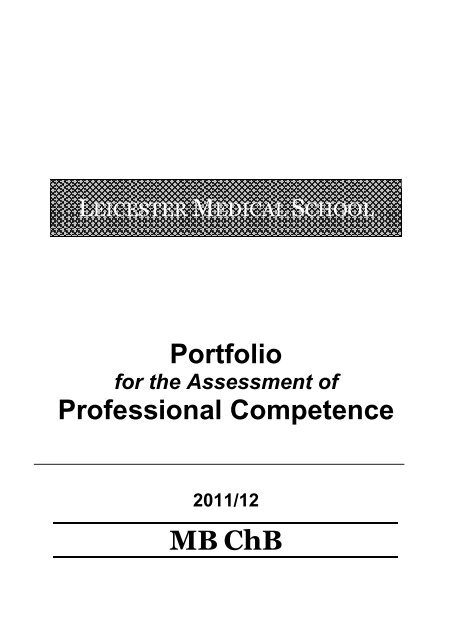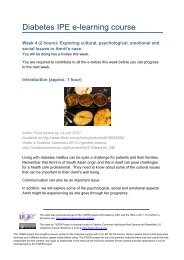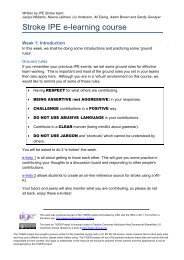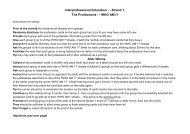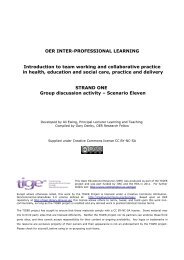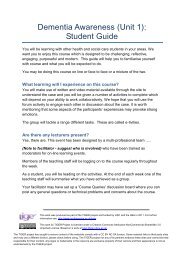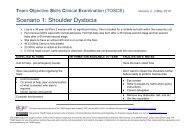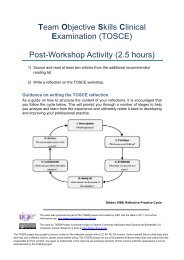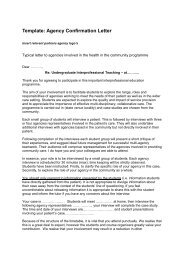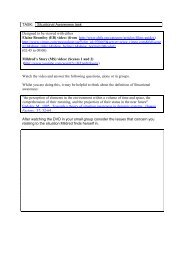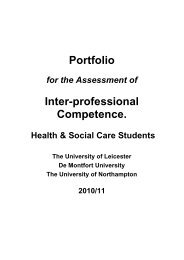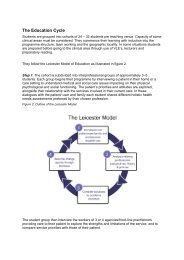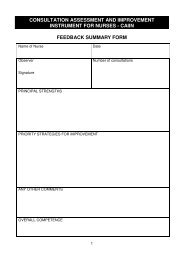Example Portfolio for students at Leicester Medical School.
Example Portfolio for students at Leicester Medical School.
Example Portfolio for students at Leicester Medical School.
Create successful ePaper yourself
Turn your PDF publications into a flip-book with our unique Google optimized e-Paper software.
LEICESTER MEDICAL SCHOOL<strong>Portfolio</strong><strong>for</strong> the Assessment ofProfessional Competence2011/12MB ChB
Personal DetailsStudent’s Name/ ID Number:___________________________________Age <strong>at</strong> entry into pre-registr<strong>at</strong>ion training:________________________Gender: MALE FEMALEPLEASE TICK Professional group:e.g. medicine___________________________________Entry intake d<strong>at</strong>e:___________________________________Mentor/Personal Tutor Name: ___________________________________If this m<strong>at</strong>erial is found please return to:2
ContentsPersonal details 2PageGlossary of Terms 4Purpose of this portfolio 5Wh<strong>at</strong> is Reflective Learning 6Wh<strong>at</strong> is Competence 8A) Professionalism in medicine 9Guidance on wh<strong>at</strong> to record 10Aims 11B) Interprofessionalism 12Guidance on wh<strong>at</strong> to record 13Aims 15Guidance on S<strong>at</strong>isfactory Completion of the <strong>Portfolio</strong> 16REFLECTIONS 17A) ProfessionalismPhase I 18Phase II 20B) Interprofessonalism 24Strand One 25Strand Two 28Strand Three 30Evidence 33Final Reflections 34Mark 37Record of Attendance 393
Glossary of TermsHEI’sHigher Educ<strong>at</strong>ion InstitutionsIPInterprofessionalIPEInterprofessional Educ<strong>at</strong>ionIPLInterprofessional LearningIPWInterprofessional workingCAIPEUK Centre <strong>for</strong> the Advancement ofInterprofessional Educ<strong>at</strong>ionwww.caipe.org.ukGMCGeneral <strong>Medical</strong> Councilwww.gmc-uk.orgHPCHealth Professions Councilwww.hpc-uk.org4
Wh<strong>at</strong> is this portfolio <strong>for</strong>?This <strong>Portfolio</strong> has two purposes:i) For Learning: This <strong>Portfolio</strong> will act as a tool <strong>for</strong> recording your learning ofprofessional and interprofessional practice.ii) For Assessment: This <strong>Portfolio</strong> is designed to contain your reflective writingon significant learning events which demonstr<strong>at</strong>e your developingcompetence (knowledge, skills, <strong>at</strong>titudes and behaviours) towards your futureprofessional practice. This writing will <strong>for</strong>m a major part of your assessmenton professionalism.A portfolio has been defined as:“A purposeful collection of student work th<strong>at</strong> exhibits the student’s ef<strong>for</strong>ts, progressand achievements in one or more areas.” (Paulson, Paulson, Meyer; 1991 1 )Professionalism and interprofessional working are two themes which run throughyour curriculum. There is general agreement th<strong>at</strong> medical <strong>students</strong> are not ready tocommence a professional career unless they have understandings rel<strong>at</strong>ed to values,beliefs, <strong>at</strong>titudes and behaviours, concerning;a) professionalism rel<strong>at</strong>ing to personal <strong>at</strong>tributes and qualitiesandb) interprofessionalism, understandings of team working and collabor<strong>at</strong>ivepractice.Teaching and learning rel<strong>at</strong>ed to professionalism and interprofessionalism are thefound<strong>at</strong>ions <strong>for</strong> your personal development towards becoming a competent doctor.These qualities are strongly rel<strong>at</strong>ed to you becoming a safe practitioner. Until thelast decade it was assumed th<strong>at</strong> these competencies were acquired whenshadowing doctors and other practitioners during clinical rot<strong>at</strong>ions. However,evidence suggests th<strong>at</strong> medical schools should provide explicit learning experiencesand assessments on professional competencies, as <strong>at</strong>titudes acquired as anundergradu<strong>at</strong>e, can persist in the longer term.Does this learning count towards my qualific<strong>at</strong>ion?Yes. You must complete the required reflections throughout your training and beready to hand in your work when requested. Your <strong>Portfolio</strong> must be completed to as<strong>at</strong>isfactory level by the end of your training. Keep this document in a safe place andtake it to all relevant teaching sessions so th<strong>at</strong> tutors can sign to confirm <strong>at</strong>tendance.This is because you will need evidence, often tutors sign<strong>at</strong>ures, th<strong>at</strong> you <strong>at</strong>tendedthe events and particip<strong>at</strong>ed. In addition we advise you to keep all your reflectivewriting, electronically. We confirm th<strong>at</strong> this <strong>Portfolio</strong> will be assessed during yourtraining and you must pass this element of medical training be<strong>for</strong>e beingprogressed as successful following the final professional examin<strong>at</strong>ion.1 Paulson, F. L., Paulson, P. R., & Meyer, C. (1991). Wh<strong>at</strong> makes a portfolio a portfolio? Educ<strong>at</strong>ional Leadership,48(5), 60-63.5
Stage Three – So Wh<strong>at</strong>? (Meaning and Applic<strong>at</strong>ion)Being able to describe something and figure out why it happened is not enough; areflective practitioner needs to see the overall meaning of events. Consider thefollowing questions:Why did this seem like a significant event to reflect on?Wh<strong>at</strong> have I learned from this? How could I improve?How might this change my future thinking, behaving, interactions?Wh<strong>at</strong> questions remain?Stage Four – Now Wh<strong>at</strong>? (Implic<strong>at</strong>ions <strong>for</strong> Action)It is in this stage th<strong>at</strong> reflection moves into action planning. Wh<strong>at</strong> are theimplic<strong>at</strong>ions of wh<strong>at</strong> you have discovered from the preceding steps? Consider thefollowing questions:Wh<strong>at</strong> will I do differently?Cycle of Reflective Learning1. ExperienceA learning eventWh<strong>at</strong> is going on? When did ithappen? Who was involved?4. Take <strong>for</strong>ward yourthinkingWh<strong>at</strong> now? Design newways of doing things.As a result of this experience Iwill now…?2. ReflectionAnalysis of the learningevent in rel<strong>at</strong>ionship to thelearning outcomesWhy did this happen? Werethere any contributory factors?3. Challenge past learningMeaning and Applic<strong>at</strong>ion.Reconstruct your knowledgeand understanding.Could this be done differently?Please go to blackboard to see some examples of poor and excellent reflections.7
Wh<strong>at</strong> is Competence?In this <strong>Portfolio</strong> you are expected to reflect on your developing competence towardsprofessional and interprofessional practice. So wh<strong>at</strong> do we mean by competence?A competent professional has an ability to handle a complex situ<strong>at</strong>ion by combining:Knowledge or cognitive domain ~ the learning of specific factsSkills or psychomotor domain ~ the practice of knowledgeAttitudes or affective domain ~ the development of feelings oremotions or appropri<strong>at</strong>e values demonstr<strong>at</strong>ed through professionalbehaviour (Miller GE, 1990 4 ).Competency is perceived as a dynamic concept. It is not merely the understandingof new knowledge, or the acquisition of a clinical skill, but an ability to use thesecomponents together and ensure a component professional per<strong>for</strong>mance (Verma,P<strong>at</strong>erson and Medves 5 ). This implies th<strong>at</strong> it is more than a set of specific knowledge,skills and <strong>at</strong>titudes; it is a coordin<strong>at</strong>ion of a persons cognitive and affective abilities.Throughout your learning journey in the medical school you are taught on theknowledge components of your curriculum. These rel<strong>at</strong>e to the doctor as a;i) scholar and scientist e.g. an<strong>at</strong>omyii) practitioner e.g. how to take a historyiii) professional e.g. ethical principles and team working theory.Once you have the knowledge you then begin to practice the skill of doing e.g. theskill of effective communic<strong>at</strong>ion, or taking a blood pressure. In addition you will beasked to complete these skills using a set of positive <strong>at</strong>titudes and values. As youbegin to work in clinical environments you will consider how to apply science,conduct clinical skills and act professionally ensuring to rel<strong>at</strong>e your work to otherrelevant colleagues. These separ<strong>at</strong>e components will be combined in your clinicallearning environments when working alongside practitioners and engaging withp<strong>at</strong>ients in the community or in hospital. In this way the separ<strong>at</strong>e aspects of yourcompetence come together. This <strong>Portfolio</strong> is concerned with how you apply yourknowledge, skills and <strong>at</strong>titudes to be professional and interprofessional. We havesepar<strong>at</strong>ed out the individual aspects of the components of being professional andinterprofessional and expect you to start to combine these components together asyou progress towards qualific<strong>at</strong>ion. However, this journey will span your career.Today’s doctors must work professionally in the following contexts:With p<strong>at</strong>ientsWithin clinical healthcare teamsAcross care p<strong>at</strong>hwaysWithin healthcare organis<strong>at</strong>ions4 Miller GE. (1990). The assessment of clinical skills/competence/per<strong>for</strong>mance. Academic Medicine, 65 (9): S63-S675 Verma, S, P<strong>at</strong>erson, M & Medves, J (2006). Core competencies <strong>for</strong> health care professionals:Wh<strong>at</strong> medicine, nursing,occup<strong>at</strong>ional therapy, and physiotherapy share. Journal of Allied Health, 35, 109 - 115.8
A) Professionalism in MedicineAlthough there are different interpret<strong>at</strong>ions of wh<strong>at</strong> ‘being a professional doctor’means there is strong agreement th<strong>at</strong> it rel<strong>at</strong>es to the quality of the doctor which is acombin<strong>at</strong>ion of relevant; knowledge, skills, and <strong>at</strong>titudes or values based on soundjudgements and integrity. In today’s modern practice arena’s doctors are required towork in partnership with the p<strong>at</strong>ient and their family/carers to negoti<strong>at</strong>e and thenagree, how to manage their care.We expect th<strong>at</strong> during your training the following aspects of being professional e.g.knowledge; skills and <strong>at</strong>titudes/values and rel<strong>at</strong>ed behaviours will be acquired topractice safely and competently during Found<strong>at</strong>ion Training and beyond:ProfessionalismTeaching to ensure a set of values, behaviours and rel<strong>at</strong>ionships th<strong>at</strong> ensurepublic trust in doctorsKnowledgeTheoretical understanding of wh<strong>at</strong> constitutes a profession including regul<strong>at</strong>ionMorality and spiritualityEthical practiceSocial responsibility and advocacyHumanitiesLaw and accountabilityConfidentiality and consentDealing with unprofessional behaviourSkillsIntegrityAltruismCommunic<strong>at</strong>ionCompassion and emp<strong>at</strong>hyRespect of cultural and ethnic diversityInteractions with p<strong>at</strong>ients to demonstr<strong>at</strong>e, confidentiality, consent, capacityLeadershipCoping with stress and uncertaintySelf awareness and insightContinuous improvement and commitment to lifelong learningValues/<strong>at</strong>titudesAppreci<strong>at</strong>ion of the values and <strong>at</strong>titudes required <strong>for</strong> positive professional practiceRecognise need <strong>for</strong> on-going personal developmentBehavioursPut into practice above learning when working with p<strong>at</strong>ients and other colleaguesAppropri<strong>at</strong>e personal and interpersonal behavioursNon-judgmental practicePersonal conduct and behaviour throughout medical school training including <strong>at</strong>tendance9
Wh<strong>at</strong> should you record?Learning events should meet the following criteria:Align to the GMC recommend<strong>at</strong>ions of professional practice and show amotiv<strong>at</strong>ion to strive to achieve theseDemonstr<strong>at</strong>e a commitment to wanting to seek to improve and to be able tocritically appraise per<strong>for</strong>manceLearning moments are rel<strong>at</strong>ed to experiences or situ<strong>at</strong>ions either undertakenin the medical school and or other training setting or in clinical practice.Phase IYou may choose to write on a reflection rel<strong>at</strong>ing to your personal developmentrel<strong>at</strong>ing to any of the following learning:Gradu<strong>at</strong>es: Aspects of professional practice from the block P<strong>at</strong>ient CentredClinical Practice (PCCP)Reflection following a lecture on professionalismExperiences during the clinical skills consult<strong>at</strong>ion skills found<strong>at</strong>ion courseSemester 4 rel<strong>at</strong>ed to Health and Disease in Society (HaDSoc)Reflections on the GMC documents rel<strong>at</strong>ing to professionalism in medicineReflections on any articles you read on professionalism in medicine.Phase IIYou must choose two situ<strong>at</strong>ions <strong>for</strong> reflection from your clinical blocks. We suggestone from your junior rot<strong>at</strong>ion and one from your senior rot<strong>at</strong>ion.These must include:a) Reflections on something you have done which shows positiveprofessional practice, or, something you have done where you couldimprove on your professional practice.b) Reflections of your observ<strong>at</strong>ions of a doctor who has behavedprofessionally.10
Aims of your Professional LearningYour learning <strong>at</strong> medical school rel<strong>at</strong>ing to your future professional practice, aims toensure th<strong>at</strong> on gradu<strong>at</strong>ion you will behave according to ethical and legal principles ofyour regul<strong>at</strong>ory body the General <strong>Medical</strong> Council.Phase I: You will be expected to:Explore wh<strong>at</strong> is meant by professionalism as outlined by the General <strong>Medical</strong>Council and apply relevant theory and policyUnderstand and apply professional behaviour e.g. being polite, consider<strong>at</strong>e,trustworthy and honestPrepare <strong>for</strong> p<strong>at</strong>ient-centred clinical care which shows respect <strong>for</strong> theindividual and their circumstancesAppraise the importance of maintaining confidentialityShow respect <strong>for</strong> those you learn with, and from, during your trainingincluding academics, practitioners and <strong>students</strong> from other professions.Phase II: You will be expected, under supervision, to:Appreci<strong>at</strong>e and apply good standards of clinical care ensuring evidencebased practicePractice personal professional behaviours to ensure p<strong>at</strong>ient-centred clinicalcareAnalyse the pivotal position of medicine to enable good working rel<strong>at</strong>ionshipswith colleagues and in teaching othersAnalyse wh<strong>at</strong> it means to consider moral and ethical issues in clinical careReflect on your developing professional competence while in practice.11
B) InterprofessionalismToday’s doctors do not practice single handedly and quality of p<strong>at</strong>ient care is mainlya collective endeavour, crossing many professional boundaries, st<strong>at</strong>utory and nonst<strong>at</strong>utoryorganis<strong>at</strong>ions. Working in teams poses new challenges <strong>for</strong> collectivedecision making and requires leaders who will take on accountability. These leadersare not necessarily doctors. Being interprofessional will require you to know yourweaknesses within a team setting and ensure they are m<strong>at</strong>ched by others strengths.InterprofessionalismTeaching th<strong>at</strong> prepares doctors to be practice-ready to work within a team andcollabor<strong>at</strong>ively to improve health outcomes.KnowledgeTheoretical understanding of team working dynamicsPsychological and sociological principles of team workingUnderstanding of the roles and responsibilities of other professions, voluntary sector andpriv<strong>at</strong>e sectorTeam based communic<strong>at</strong>ionLeadership/managementEthical principles, stereotypingConstituents of safe team-based practiceSkillsNegoti<strong>at</strong>ionInterprofessional communic<strong>at</strong>ionLeadershipPartnership workingExchange of skills and teachingP<strong>at</strong>ient-centred careEmotional intelligence (in a team context)Recognise limits (in a team context)Values/<strong>at</strong>titudesAppreci<strong>at</strong>ion of the values and <strong>at</strong>titudes required <strong>for</strong> positive inter-professional practiceRecognise need <strong>for</strong> on-going personal developmentBehavioursPut into practice above learning when working with p<strong>at</strong>ients and other colleaguesRecognise the scope of other disciplines practiceTre<strong>at</strong> other colleagues with respect and dignity etc12
Wh<strong>at</strong> interprofessional events can I record?Learning events must meet these criteria:There must be <strong>at</strong> least two different professions present <strong>at</strong> the learningmoment (these maybe <strong>students</strong> or qualified practitioners)The learning event must be interactive. There must be an opportunity to learnabout each other’s roles and responsibilities and to learn through theexchange of knowledge and ideas.Learning Strand OneLearning Strand TwoLearning Strand ThreeEarly classroom based learning rel<strong>at</strong>ing to the theory ofteam workingHealth in the Community - team working andcollabor<strong>at</strong>ive practiceP<strong>at</strong>ient Safety Workshops and simul<strong>at</strong>ion events,Listening Workshops with service users, learning inteams about elderly care, those with mental illness,children, cancer, diabetic etc and e-learning possibilities.Increasing Interprofessional CompetenciesStrand ThreeStrand TwoStrand OneMainly Universitygroup workP<strong>at</strong>ient* focussedactivity.Mostly practice basedlearning.P<strong>at</strong>ient* focussedactivity.Mostly practicebased learning withan e-learning event.*P<strong>at</strong>ient/service user/clientInterprofessional Educ<strong>at</strong>ionIn 1988 the World Health Organis<strong>at</strong>ion endorsed interprofessional learning, “Learntogether to work together”. Effective team working benefits p<strong>at</strong>ients/serviceusers/clients and has been found to improve professional working lives (Borrill et al;2000 6 ; WHO 2010). These learning events will help you think and learn in differentways throughout your training.6 Borrill C, West M, Shapiro D, Rees A. (2000) Team working and effectiveness in health care. British Journal ofHealth Care Management. 6(8): 364-371.World Health Educ<strong>at</strong>ion. (2010). Framework <strong>for</strong> action on interprofessional educ<strong>at</strong>ion & collabor<strong>at</strong>ive practice,Geneva: WHO.13
Interprofessional Educ<strong>at</strong>ion is not separ<strong>at</strong>e but an integral part of youruni-professional study.14
Aims of your Interprofessional Educ<strong>at</strong>ion (IPE)STRAND ONEAimsTo explore wh<strong>at</strong> is meant by team working in health and social careTo begin to apply a theoretical understanding to team workTo become familiar with your chosen profession and othersTo consider the outcomes of team working <strong>for</strong> promoting person-centredcollabor<strong>at</strong>ive care.STRAND TWOAimsTo apply the theoretical basis of team workingTo gain a richer appreci<strong>at</strong>ion of roles and responsibilities of practitionersTo analyse effective collabor<strong>at</strong>ive team practiceTo consider your future contribution to person-centred team working.STRAND THREEAimsTo provide context(s) <strong>for</strong> applying and developing working competence topracticeAnalyse and reflect on challenging real situ<strong>at</strong>ions to consider solutions toimprove team based careTo develop an understanding of how individual professional competenciescomplement those of other professionsTo develop an understanding of team working in modern health and socialcare and educ<strong>at</strong>ion.15
Guidance on How to Complete a S<strong>at</strong>isfactory <strong>Portfolio</strong>In order to pass you must submit a completed portfolio containing:The required minimum number of reflections showing aspects ofprofessionalismA signed record of <strong>at</strong>tendance <strong>for</strong> organised IPE to show th<strong>at</strong> you have<strong>at</strong>tended a minimum of three events e.g. strand one, two and three.Completed writing which shows reflection on competence e.g. developingknowledge, skills, <strong>at</strong>titudes and behaviourProfessional writing within the word limitA completed final reflection prior to finalsThe marking criteria will be placed on blackboardWh<strong>at</strong> Support Can I Expect?Your personal tutor would be able to help with any problems and there will be IPEtutors <strong>at</strong> all organised interprofessional learning events.Reading ListGeneral <strong>Medical</strong> Council. (2006) Good <strong>Medical</strong> Practice: GMC,, London.General <strong>Medical</strong> Council. (2007). <strong>Medical</strong> <strong>students</strong>: professional behaviour and fitness to practise.Guidance from the General <strong>Medical</strong> Council and the <strong>Medical</strong> <strong>School</strong>s Council, London, GMC.Gibbs, G.(1988). Cre<strong>at</strong>ing a Teaching <strong>Portfolio</strong>. Technical and Educ<strong>at</strong>ional Services Ltd, Bristol.Hammick, M., Freeth, D., Copperman, J. & Goodsman, D. (2009). Being Interprofessional. PolityPress, Cambridge.Hilton, S. & Southg<strong>at</strong>e, L. (2007). Professionalism in <strong>Medical</strong> Educ<strong>at</strong>ion. Teaching and TeacherEduc<strong>at</strong>ion, 23, 265–279.Hutchings. S., Hall, J., & Lovelady, B. (2003). Teamwork. A guide to successful Collabor<strong>at</strong>ion inHealth and social Care. Speechmark, Publishing LTD, Oxon.Levenson, R., Dewar, S. & Shepherd, S. (2008).Understanding Doctors- Harnessing Professionalism.London: Kings Fund : Royal College of Physicians.Levenson, R., Atkinson, S. & Shepherd,S. (2010). The Twenty First Century Doctor. Understandingthe Doctors of Tomorrow. Kings Fund: Royal College of Physicians: Kings Fund, London.McNair, R. (2005). The case <strong>for</strong> educ<strong>at</strong>ing medical <strong>students</strong> in professionalism as the core content ofinterprofessional educ<strong>at</strong>ion. <strong>Medical</strong> Educ<strong>at</strong>ion, 39, 456-464.Miller, C., Freeman, M., Ross, N. (2001). Interprofessional Practice in Health and Social Care.Challenging the shared learning agenda. Arnold. London.Moon, J. (1999). Reflection in Learning and Professional Development, Kogan Page, London.Royal College of Physicians. (2005). Doctors in society: medical professionalism in a changing world.Report of a Working Party of the Royal College of Physicians: London, RCP.Schön, DA. (1987) Educ<strong>at</strong>ing the Reflective Practitioner, Jossey-Bass Publishers, San Francisco.Thistlethwaite, J & Spencer, J (2008). Professionalism in Medicine. Radcliffe-Publishing Ltd. Oxen.16
REFLECTIONSSection A) ProfessionalismSection B) Interprofessionalism17
SECTION APhase IProfessional Learning: Personal DevelopmentWhen and with whom?(Enter the d<strong>at</strong>e)Reflections (1,000 words)Wh<strong>at</strong>? And so wh<strong>at</strong>?Where?(St<strong>at</strong>e the locality/NHS site)REFLECTION18
Phase IIProfessional Learning: Reflections on something you havedone which shows learning towards developing good professionalpracticeWhen and with whom?(Enter the d<strong>at</strong>e)Reflections (1,000 words)Wh<strong>at</strong>? And so wh<strong>at</strong>?Where?(St<strong>at</strong>e the locality/NHS site)REFLECTION20
Phase IIProfessional Learning: Observ<strong>at</strong>ion of a doctor’s ProfessionalPracticeWhen and with whom?(Enter the d<strong>at</strong>e)Reflections (1,000 words)Wh<strong>at</strong>? And so wh<strong>at</strong>?Where?(St<strong>at</strong>e the locality/NHS site)REFLECTION22
Section BInterprofessional WorkingReflections from induction weekWhen and with whom?(Enter the d<strong>at</strong>e and which profession<strong>students</strong> were working towards)Where?(St<strong>at</strong>e the locality/NHS site)<strong>Medical</strong> <strong>School</strong>27 th September 2011Class-room learning in medicalschoolReflections: on interprofessional working (500 words)Consider the discussions in your group. Wh<strong>at</strong> was important <strong>for</strong> you andwhy?24
Interprofessional Learning (IPL) EventsStrand One (Phase I)When and with whom?(Enter the d<strong>at</strong>e and which profession<strong>students</strong> were working towards)Where?(St<strong>at</strong>e the locality/NHS site)ReflectionsWh<strong>at</strong>? And so wh<strong>at</strong>?Wh<strong>at</strong> did you learn about? Brief summary only- approxim<strong>at</strong>ely 200 words.25
How did this learning advance your developing interprofessionalcompetence? (So wh<strong>at</strong>?) An analytical personal reflection of approxim<strong>at</strong>ely 1,000words26
Interprofessional Learning (IPL) EventsStrand Two (Phase I)When and with whom?(Enter the d<strong>at</strong>e and which profession<strong>students</strong> were working towards)Where?(St<strong>at</strong>e the locality/NHS site)ReflectionsWh<strong>at</strong>? And so wh<strong>at</strong>?Wh<strong>at</strong> did you learn about? Brief summary only- approxim<strong>at</strong>ely 200 words.28
How did this learning advance your developing interprofessionalcompetence? (So wh<strong>at</strong>?) An analytical personal reflection of approxim<strong>at</strong>ely 1,000words29
Interprofessional Learning (IPL) EventsStrand Three (Phase II)When and with whom?(Enter the d<strong>at</strong>e and which profession<strong>students</strong> were working towards)Where?(St<strong>at</strong>e the locality/NHS site)ReflectionsWh<strong>at</strong>? And so wh<strong>at</strong>?Wh<strong>at</strong> did you learn about? Brief summary only- approxim<strong>at</strong>ely 200 words.31
How did this learning advance your developing interprofessionalcompetence? (So wh<strong>at</strong>?) An analytical personal reflection of approxim<strong>at</strong>ely 1,000words32
EVIDENCE sectionD<strong>at</strong>eWh<strong>at</strong> Learningexperience doesit rel<strong>at</strong>e toDescription of wh<strong>at</strong>evidenceWh<strong>at</strong> knowledge skillsand <strong>at</strong>titudes does itdemonstr<strong>at</strong>ePlease insert your evidence after this page in d<strong>at</strong>e order and or store in a safe place33
SECTION FIVEFinal Reflections34
ProfessionalismFinal –reflections <strong>for</strong>your futurepracticeAs a result of your journey wh<strong>at</strong> knowledge skills and<strong>at</strong>titudes have you developed towards becoming anProfessional Doctor and how will you use and develop thislearning in your future practice35
InterprofessionalismFinal –reflections <strong>for</strong>your futurepracticeAs a result of your journey wh<strong>at</strong> knowledge skills and<strong>at</strong>titudes have you developed towards becoming aninterprofessional team member and able to engage withcollabor<strong>at</strong>ive working. How will you use and develop thislearning in your future practice36
Tutor comments and reflections:FINAL: Tutors Marking SheetMark:Tutor sign<strong>at</strong>ure:Student comments:Student sign<strong>at</strong>ure:38
Record of Attendance39
STRAND ONEWh<strong>at</strong> D<strong>at</strong>e Student Sign<strong>at</strong>ure Authorising Sign<strong>at</strong>ureLaunch VideoCourseexplan<strong>at</strong>ion27/9/11Session 1Introduction toIPESession 2Introduction toIPESession 3Gradu<strong>at</strong>es onlyOtherTutor/Facilit<strong>at</strong>or Comment Box40
Strand TwoWh<strong>at</strong> D<strong>at</strong>e Student Sign<strong>at</strong>ure Authorising Sign<strong>at</strong>ureTutor/Facilit<strong>at</strong>or Comment Box41
Strand ThreeWh<strong>at</strong> D<strong>at</strong>e Student Sign<strong>at</strong>ure Authorising Sign<strong>at</strong>ureTutor/Facilit<strong>at</strong>or Comment Box42


